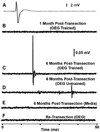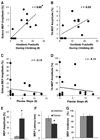Further evidence of olfactory ensheathing glia facilitating axonal regeneration after a complete spinal cord transection
- PMID: 21272578
- PMCID: PMC3085566
- DOI: 10.1016/j.expneurol.2011.01.007
Further evidence of olfactory ensheathing glia facilitating axonal regeneration after a complete spinal cord transection
Abstract
Spinal Wistar Hannover rats injected with olfactory ensheathing glia (OEG) have been shown to recover some bipedal stepping and climbing abilities. Given the intrinsic ability of the spinal cord to regain stepping with pharmacological agents or epidural stimulation after a complete mid-thoracic transection, we asked if functional recovery after OEG injections is due to changes in the caudal stump or facilitation of functional regeneration of axons across the transection site. OEG were injected rostral and caudal to the transection site immediately after transection. Robotically assisted step training in the presence of intrathecal injections of a 5-HT(2A) receptor agonist (quipazine) was used to facilitate recovery of stepping. Bipedal stepping as well as climbing abilities were tested over a 6-month period post-transection to determine any improvement in hindlimb functional due to OEG injections and/or step training. The ability for OEG to facilitate regeneration was analyzed electrophysiologically by transcranially stimulating the brainstem and recording motor evoked potentials (MEP) with chronically implanted intramuscular EMG electrodes in the soleus and tibalis anterior with and without intrathecal injections of noradrenergic, serotonergic, and glycinergic receptor antagonists. Analyses confirmed that along with improved stepping ability and increased use of the hindlimbs during climbing, only OEG rats showed recovery of MEP. In addition the MEP signals were eliminated after a re-transection of the spinal cord rostral to the original transection and were modified in the presence of receptor antagonists. These data indicate that improved hindlimb function after a complete transection was coupled with OEG-facilitated functional regeneration of axons. This article is part of a Special Issue entitled: Understanding olfactory ensheathing glia and their prospect for nervous system repair.
Published by Elsevier Inc.
Figures











Similar articles
-
Noradrenergic innervation of the rat spinal cord caudal to a complete spinal cord transection: effects of olfactory ensheathing glia.Exp Neurol. 2010 Mar;222(1):59-69. doi: 10.1016/j.expneurol.2009.12.008. Epub 2009 Dec 16. Exp Neurol. 2010. PMID: 20025875 Free PMC article.
-
OEG implantation and step training enhance hindlimb-stepping ability in adult spinal transected rats.Brain. 2008 Jan;131(Pt 1):264-76. doi: 10.1093/brain/awm267. Epub 2007 Dec 3. Brain. 2008. PMID: 18056162 Free PMC article.
-
Serotonergic innervation of the caudal spinal stump in rats after complete spinal transection: effect of olfactory ensheathing glia.J Comp Neurol. 2009 Aug 20;515(6):664-76. doi: 10.1002/cne.22080. J Comp Neurol. 2009. PMID: 19496067 Free PMC article.
-
Clinical application of adult olfactory bulb ensheathing glia for nervous system repair.Exp Neurol. 2011 May;229(1):181-94. doi: 10.1016/j.expneurol.2010.10.001. Epub 2010 Oct 12. Exp Neurol. 2011. PMID: 20946896 Review.
-
Olfactory ensheathing glia: their contribution to primary olfactory nervous system regeneration and their regenerative potential following transplantation into the injured spinal cord.Brain Res Rev. 2007 Nov;56(1):236-58. doi: 10.1016/j.brainresrev.2007.07.013. Epub 2007 Aug 14. Brain Res Rev. 2007. PMID: 17884174 Review.
Cited by
-
High-Yield Mucosal Olfactory Ensheathing Cells Restore Loss of Function in Rat Dorsal Root Injury.Cells. 2021 May 12;10(5):1186. doi: 10.3390/cells10051186. Cells. 2021. PMID: 34066218 Free PMC article.
-
Update of application of olfactory ensheathing cells and stem cells/exosomes in the treatment of retinal disorders.Stem Cell Res Ther. 2022 Jan 10;13(1):11. doi: 10.1186/s13287-021-02685-z. Stem Cell Res Ther. 2022. PMID: 35012635 Free PMC article. Review.
-
Reliable cell purification and determination of cell purity: crucial aspects of olfactory ensheathing cell transplantation for spinal cord repair.Neural Regen Res. 2020 Nov;15(11):2016-2026. doi: 10.4103/1673-5374.282218. Neural Regen Res. 2020. PMID: 32394949 Free PMC article. Review.
-
Functional Recovery Following the Transplantation of Olfactory Ensheathing Cells in Rat Spinal Cord Injury Model.Asian Spine J. 2018 Dec;12(6):998-1009. doi: 10.31616/asj.2018.12.6.998. Epub 2018 Oct 16. Asian Spine J. 2018. PMID: 30322257 Free PMC article.
-
Interactive Effects Between Exercise and Serotonergic Pharmacotherapy on Cortical Reorganization After Spinal Cord Injury.Neurorehabil Neural Repair. 2016 Jun;30(5):479-89. doi: 10.1177/1545968315600523. Epub 2015 Sep 3. Neurorehabil Neural Repair. 2016. PMID: 26338432 Free PMC article.
References
-
- Boulenguez P, Liabeuf S, Bos R, Bras H, Jean-Xavier C, Brocard C, Stil A, Darbon P, Cattaert D, Delpire E, Marsala M, Vinay L. Down-regulation of the potassium-chloride cotransporter KCC2 contributes to spasticity after spinal cord injury. Nat. Med. 2010;16:302–307. - PubMed
-
- de Leon RD, Acosta CN. Effect of robotic-assisted treadmill training and chronic quipazine treatment on hindlimb stepping in spinally transected rats. J. Neurotrama. 2006;23:1147–1163. - PubMed
-
- de Leon RD, Tamaki H, Hodgson JA, Roy RR, Edgerton VR. Hindlimb locomotor and postural training modulates glycinergic inhibition in the spinal cord of the adult spinal cat. J. Neurophysiol. 1999;82:359–369. - PubMed
-
- Edgerton VR, Roy RR. Spasticity: a switch from inhibition to excitation. Nat. Med. 2010;16:270–271. - PubMed

